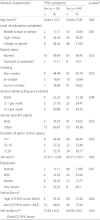1. Carlier IV, Lamberts RD, Gersons BP. Risk factors for posttraumatic stress symptomatology in police officers: A prospective analysis. J Nerv Ment Dis. 1997; 185:498–506. DOI:
10.1097/00005053-199708000-00004. PMID:
9284863.
2. Foa EB, Hearst-Ikeda D, Perry KJ. Evaluation of a brief cognitive-behavioral program for the prevention of chronic PTSD in recent assault victims. J Consult Clin Psychol. 1995; 63:948–955. DOI:
10.1037/0022-006X.63.6.948. PMID:
8543717.
3. Robinson HM, Sigman MR, Wilson JP. Duty-related stressors and PTSD symptoms in suburban police officers. Psychol Rep. 1997; 81:835–845. DOI:
10.2466/pr0.1997.81.3.835. PMID:
9400075.
4. Marmar CR, McCaslin SE, Metzler TJ, Best S, Weiss DS, Fagan J, et al. Predictors of posttraumatic stress in police and other first responders. Ann N Y Acad Sci. 2006;1071:1–18.
5. Rutter M. Resilience in the face of adversity: Protective factors and resistance to psychiatry disorder. Br J Psychiatry. 1985; 147:598–611. DOI:
10.1192/bjp.147.6.598. PMID:
3830321.
6. Han YM. Relationships between self resilience and psychological health in college students. Seoul, Korea: Doctoral thesis of Hongik University Graduate School; 2009. vol. 30, p. 97–110.
7. Caver CS, Scheier MF. Unresolved issues regarding the meaning and measurement of explanatory style. Psychol Inq. 1991; 2:21–24. DOI:
10.1207/s15327965pli0201_5.
8. Brewin CR, Andrews B, Valentine JD. Meta-analysis of risk factors for posttraumatic stress disorder in trauma-exposed adults. J Consult Clin Psychol. 2000; 68:748–766. DOI:
10.1037/0022-006X.68.5.748. PMID:
11068961.
10. Yuan C. Protective factors for posttraumatic stress disorder symptoms in a prospective study of police officers. Psychiatry Res. 2011; 188:45–50. DOI:
10.1016/j.psychres.2010.10.034. PMID:
21095622.
11. Chang SJ. Standardization of job stress measurement scale for Korean employee. Incheon: Korea Occupational Safety and Health Agency. 2004;17–41. Korean.
13. Connor KM, Davidson JRT. Development of a new resilience scale: The Connor-Davidson Resilience scale (CD-RISC), depression, and anxiety. Depress Anxiety. 2003; 18:76–82. DOI:
10.1002/da.10113. PMID:
12964174.
14. Lee JS. Resilience buffers the impact of traumatic events on the development of PTSD symptoms in firefighters. J Affect Disord. 2014; 162:128–133. DOI:
10.1016/j.jad.2014.02.031. PMID:
24767017.
15. Jung YE. The Korean version of the Connor-Davidson Resilience Scale: An extended validation. Stress Health. 2012; 28:319–326. DOI:
10.1002/smi.1436. PMID:
23015460.
16. Heinrichs M. Predicting posttraumatic stress symptoms from pre-traumatic risk factors: a 2 year prospective follow-up study in firefighters. Am J Psychiatry. 2005; 162:2276–2286. DOI:
10.1176/appi.ajp.162.12.2276. PMID:
16330591.
17. David S. Trauma exposed firefighters; Relationships among posttraumatic growth, posttraumatic stress, resource availability, coping and critical incident stress debriefing experience. Stress Health. 2014; 30:356–365. DOI:
10.1002/smi.2608. PMID:
25476961.
18. Bryant RA, Guthrie RM. Maladaptive self appraisals before trauma exposure predict posttraumatic stress disorder. J Consult Clin Psychol. 2007; 75:812–815. DOI:
10.1037/0022-006X.75.5.812. PMID:
17907863.
19. Agaibi CE, Wilson JP. Trauma, PTSD, and resilience: A review of the literature. Trauma Violence Abuse. 2005; 6:195–216. DOI:
10.1177/1524838005277438. PMID:
16237155.
20. Hoge EA, Austin ED, Pollack MH. Resilience: Research evidence and conceptual considerations for posttraumatic stress disorder. Depress Anxiety. 2007; 24:139–152. DOI:
10.1002/da.20175. PMID:
16892420.
21. Roy A, Carli V, Sarchiapone M. Resilience mitigates the suicide risk associated with childhood trauma. J Affect Disord. 2011; 133:591–594. DOI:
10.1016/j.jad.2011.05.006. PMID:
21621850.
22. Wingo AP, Wrenn G, Pelletier T, Gutman AR, Bradley B, Ressler KJ. Moderating effects of resilience on depression in individuals with a history of childhood abuse or trauma exposure. J Affect Disord. 2010; 126:411–414. DOI:
10.1016/j.jad.2010.04.009. PMID:
20488545.
23. Pietrzak RH, Johnson DC, Goldstein MB, Malley JC, Rivers AJ, Morgan CA, et al. Psychosocial buffers of traumatic stress, depressive symptoms, and psychosocial difficulties in veterans of Operations Enduring Freedom and Iraqi Freedom: The role of resilience, unit support, and postdeployment social support. J Affect Disord. 2010; 120:188–192. DOI:
10.1016/j.jad.2009.04.015. PMID:
19443043.
24. Benight CC, Harper ML. Coping self-efficacy perceptions as a mediator between acute stress response and long-term distress following natural disasters. J Trauma Stress. 2002; 15:177–186. DOI:
10.1023/A:1015295025950. PMID:
12092909.
25. Benight CC, Antoni MH, Kilbourn K, Ironson G, Kumar MA, Fletcher MA, et al. Coping self-efficacy buffers psychological and physiological disturbances in HIV-infected men following a natural disaster. Health Psychol. 1997; 16:248–255. DOI:
10.1037/0278-6133.16.3.248. PMID:
9152703.
26. Saigh PA, Mroueh M, Zimmerman BJ, Fairbank JA. Self-efficacy expectations among traumatized adolescents. Behav Res Ther. 1995; 33:701–704. DOI:
10.1016/0005-7967(94)00092-X. PMID:
7654163.
28. Kraemer HC, Stice E, Kazdin A, Offord D, Kupfer D. How do risk factors work together? mediators, moderators, and independent, overlapping, and proxy risk factors. Am J Psychiatry. 2001; 158:848–856. DOI:
10.1176/appi.ajp.158.6.848. PMID:
11384888.






 PDF
PDF Citation
Citation Print
Print


 XML Download
XML Download